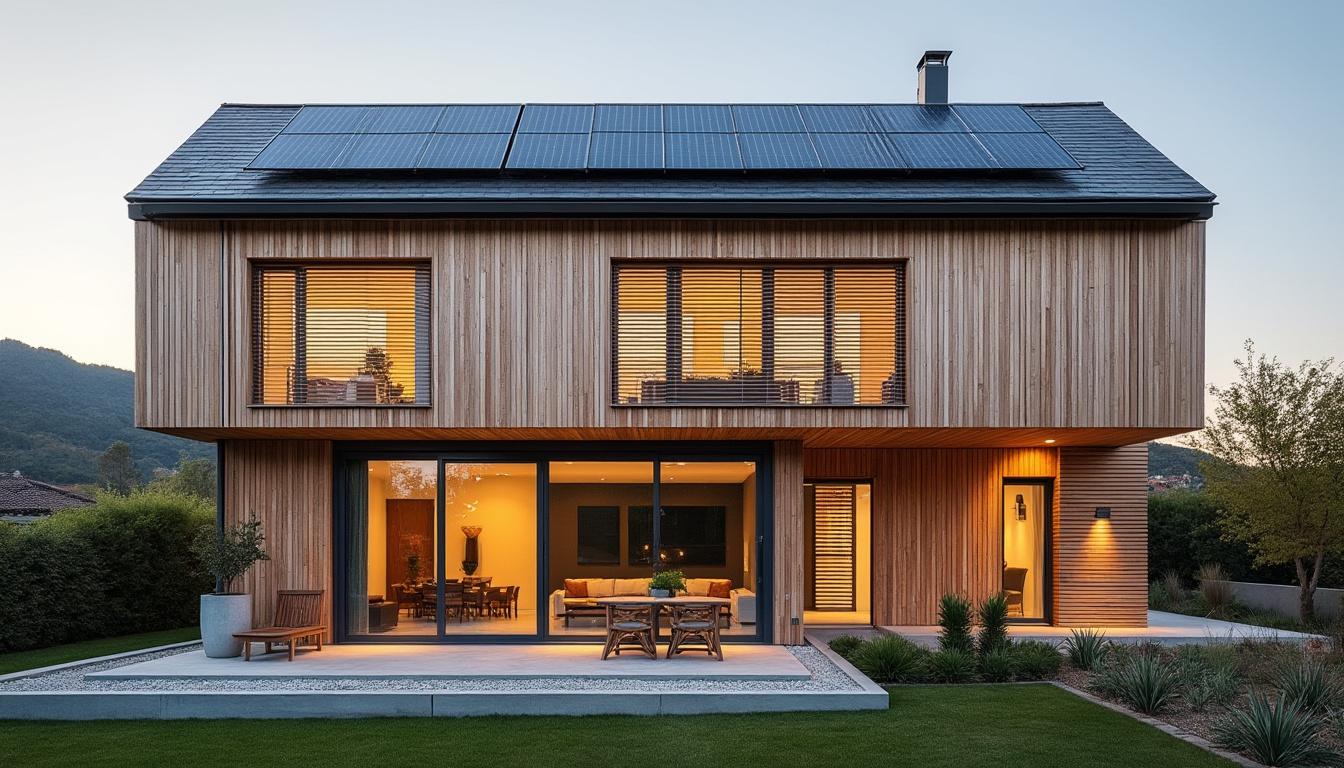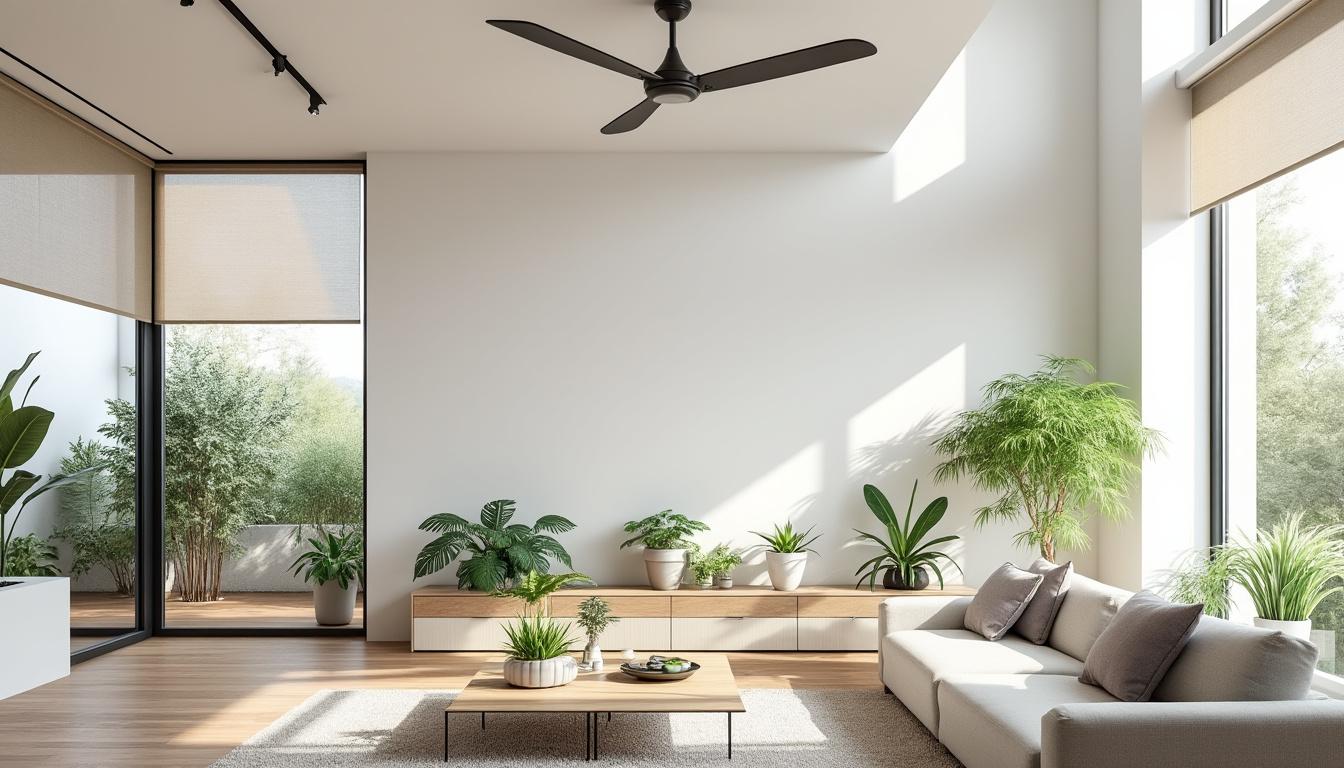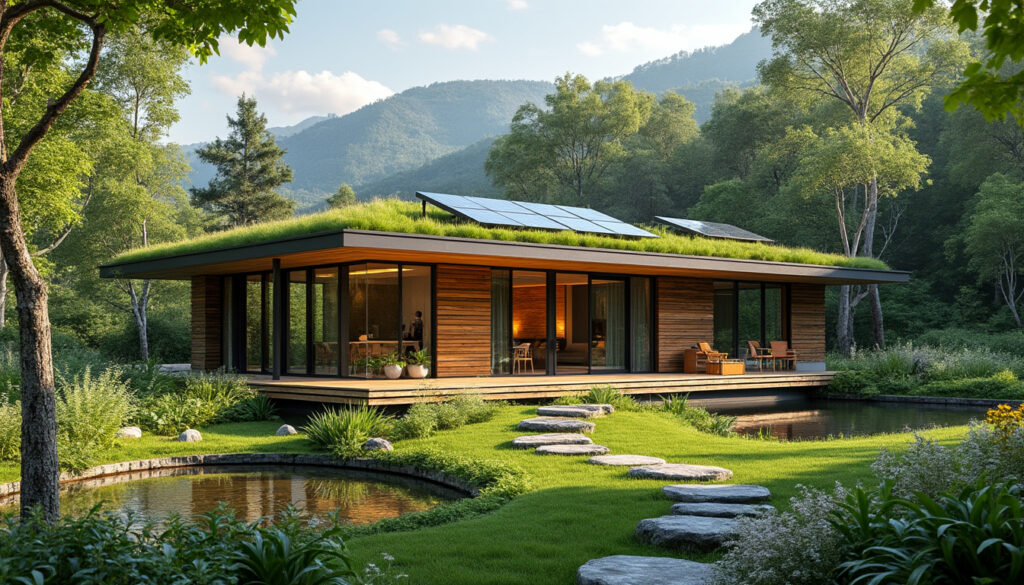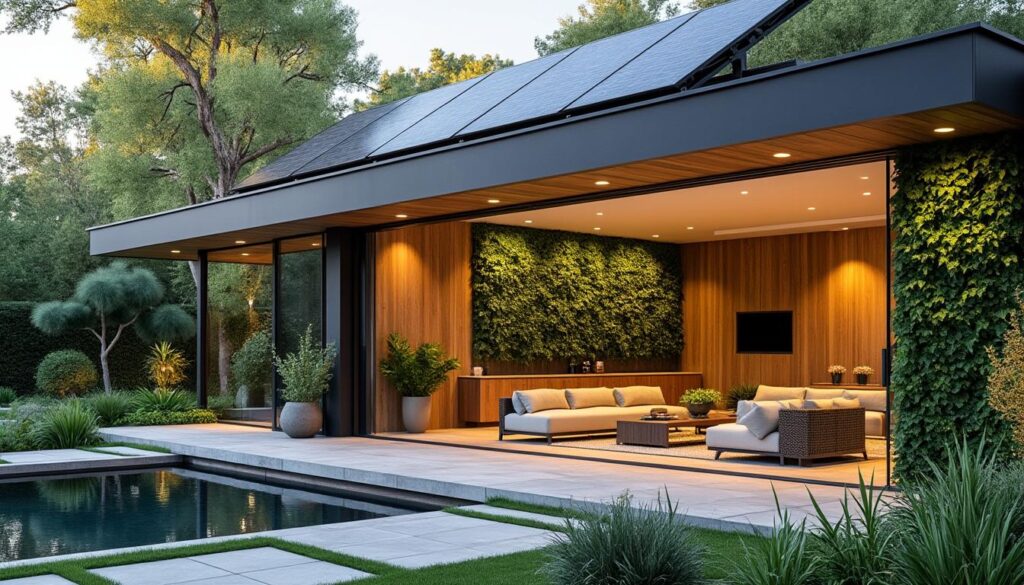Saving energy in 2026 involves intelligently applying passive house principles, accessible technologies, and consistent habits. This guide brings together practical paths for you to move towards a comfortable, low-consumption home today.
Short on time? Here’s the essentials:
| ✅ Key Points | How to Apply | Impact 💡 |
|---|---|---|
| Insulation and airtightness | Reinforce walls, roof, and windows with good sealing | Greater comfort and less thermal loss 🔒 |
| Solar self-consumption ☀️ | Panels + battery sized to your profile | Up to 70% savings on the bill ⚡ |
| Efficient climate control | Heat pump + ventilation with heat recovery | -50% consumption vs. traditional systems ❄️🔥 |
| Automation and habits | Program equipment, eliminate stand-by | Quick and cumulative gains 💸 |
Passive house in 2026: essential principles to reduce consumption without losing comfort
A passive house is not a style but a performance: spending very little to heat or cool while keeping indoor air healthy. This is achieved with a robust thermal envelope, air tightness, and controlled ventilation, making the most of solar energy and local winds.
In practice, the “Campos Family,” living in a 90s semi-detached house, decided to follow these principles for 2026: they reinforced the attic insulation, replaced windows with low-emissive double glazing, and installed mechanical ventilation with heat recovery (MVHR). The result? Stable temperatures year-round and controlled humidity, with fewer hours of heating and cooling.
Thermal insulation and control of thermal bridges
To insulate is to block the escape of heat in winter and excessive heat entry in summer. But it’s not enough to just “fill” walls: it’s essential to address thermal bridges (junctions of slabs, columns, frames), places where heat escapes most rapidly. Materials like mineral wool, wood fiber, and high-performance panels work well when applied continuously.
A homogeneous layer on the roof (the most critical point), walls, and, when possible, under the floor, creates the ideal “coat.” Complementing this with low-emissive glass and well-installed frames prevents condensation and noise, improving acoustic comfort.
Air tightness and blower door test
Cracks and gaps allow treated air to escape. Membranes, tapes, and sealants form a stable air barrier. The blower door test measures unintended air renewal: low numbers mean less infiltration and therefore less wasted energy.
Sealing roller shutter boxes, pipe passages, and installation points is a low-cost action with immediate benefits. In renovations, the right order (sealing before closing walls) avoids rework.
Ventilation with heat recovery (VHR)
Ventilation is vital for removing CO₂, humidity, and pollutants. VHR exchanges heat between outgoing and incoming air, ensuring fresh air with low energy loss. In hot climates, enthalpy recovery also helps control humidity.
For the Campos family, VHR reduced mold and persistent odors, along with making the air more stable at night. Maintenance consists of clean filters and an annual check of the equipment.
- 🏠 Reinforce the roof insulation first: the best return per euro invested.
- 🔍 Address thermal bridges in windows, columns, and shutter boxes.
- 🔒 Conduct a blower door test to guide sealing corrections.
- 🌬️ Adopt VHR to ensure healthy air with low energy loss.
| Key Element | What to Do in 2026 | Main Benefit 🎯 |
|---|---|---|
| Insulation | Roof + walls with continuous materials | Less thermal load and stable comfort ❄️🔥 |
| Windows | Low emissivity, well-sealed frames | Reduction of losses and external noise 🔇 |
| Airtightness | Membranes, sealants, tapes, and blower door | Zero unwanted infiltrations 🔧 |
| Ventilation | MVHR with easy-to-change filters | Healthy air with low expenditure 🌿 |
To move forward safely, prioritize the envelope: everything else (equipment) will work better when losses are controlled.

Photovoltaic self-consumption in 2026: panels, batteries, and the path to 70% savings
With more expensive energy and ambitious climate goals, photovoltaic self-consumption is the “engine” of the modern passive house. Using the roof to generate electricity reduces the bill and dependence on the grid, especially when combined with batteries and smart management.
Recent studies point to savings that can reach up to 70% on the electricity bill, varying with habits, local irradiation, incentives, and sizing. In 2026, solutions plugged into apps facilitate monitoring generation, consumption, and export to the grid, making decisions quicker and more accurate.
Practical sizing: matching production with consumption
The rule is to align installed power with daily profile. Those who work outside can benefit from batteries to shift energy for night use. Meanwhile, those spending more time at home can take advantage of direct production: washing machines, dishwashers, and water heating scheduled for solar hours.
Payback periods continue to range between 5 and 10 years in many areas, shortening with municipal or national incentives. Condominiums and energy communities increase access, allowing sharing production among neighbors.
Fully electric house: heat pump + PV
By replacing gas boilers with heat pumps, the home becomes “fully electric.” Heating of spaces and water is now powered by solar production, reducing emissions and simplifying maintenance. On cloudy days, the efficiency of the heat pump keeps consumption in check.
- ☀️ Optimize the tilt and orientation of panels for maximum production.
- 🔋 Consider a battery if peak consumption is at night.
- 📲 Use automation to turn equipment on at solar times.
- 🤝 Explore energy communities in your neighborhood.
| Scenario | 2026 Setup | Estimated Savings 💰 | Notes |
|---|---|---|---|
| Daytime profile | 3–4 kWp, no battery | 40–60% ✅ | Consumption shifted to solar periods ⏱️ |
| Nighttime profile | 5–7 kWp + 5–10 kWh battery | 60–75% ⚡ | Greater independence at night 🌙 |
| Electric house | 6–10 kWp + heat pump | 70%+ 🔋 | Integrates DHW and climate control 🔄 |
Want to start small and grow later? Modular systems make it easy to expand panels and batteries as the budget allows.
Efficient climate control: heat pumps, ceiling fans, and bioclimatic shading
To spend little and live well, combine the right technologies with passive solutions. Aerothermal heat pumps provide high performance for heating and cooling, while ceiling fans and blinds do the “silent work” of increasing comfort with low consumption.
Compared to gas boilers or electric resistances, heat pumps can reduce consumption by more than 50%, thanks to their high COP. When integrated with photovoltaics, they become even more interesting, especially in well-insulated homes.
Aerothermal heat pumps: the heart of comfort
Air-to-air and air-to-water models cover everything from apartments to large homes. The secret is sizing: under or oversized units reduce efficiency. Features like climate curve and fine modulation prevent spikes and noise.
For DHW, well-insulated tanks and scheduling during solar hours lower costs. Periodic maintenance (filters, checking fluids) prolongs lifespan and maintains performance over the years.
Passive strategies and fans: comfort with minimal watts
Shading with brise-soleils, blinds, and bioclimatic pergolas limits solar gains in summer without blocking winter light. Night ventilation cools the house structure when temperatures drop, reducing the workload of air conditioning the next day.
Ceiling fans consume few watts and increase comfort by 2–3 ºC. In winter mode, they push warm air down from the top, balancing the temperature.
- 🌀 Use ceiling fans before turning on the air conditioning.
- 🌘 Perform night purging by opening opposing windows for cross ventilation.
- 🌿 Install pergolas or exterior shading on the most exposed facades.
- 🧊 Schedule DHW to heat when there is sunlight.
| Solution | How to Apply | Effect on Consumption 📉 |
|---|---|---|
| Heat pump | Correct sizing + annual maintenance | -50% or more vs. traditional systems 🔥 |
| Ceiling fans | Summer/winter mode and proper rotation | Air conditioning uses less and for less time 🕒 |
| Shading | Brise-soleils, blinds, bioclimatic pergolas | Less solar gain and heat spikes ☀️ |
| Night ventilation | Opposing windows and temperature sensors | House “recharges freshness” overnight 🌙 |
When the envelope is good and shading works, the heat pump runs less. This is the synergy that makes the passive house shine.

Smart technology and habits that truly reduce the bill in 2026
Automation is not a luxury: it is a tool to bring visibility to consumption and turn data into daily decisions. Smart meters and apps already show peaks, energy-hungry appliances, and opportunities for adjustments. Small habits, repeated, add up significantly.
Appliances with AI help optimize cycles and self-diagnose problems. Refrigerators with internal monitoring prevent food waste. Smart plugs turn off energy “vampires” during the night and when away from home.
High-impact weekly routines
Organizing energy-intensive tasks for the solar period reduces purchases from the grid. Scheduling machines, charging electric vehicles, and heating water from 11 am to 4 pm, for example, takes advantage of the typical photovoltaic production curve.
Another aspect is light maintenance: cleaning air filters, defrosting freezers, and adjusting temperatures (19–21 ºC in winter; 25–26 ºC in summer) maintain efficiency without sacrificing comfort. Simple tricks like placing a cork stopper in the refrigerator to absorb moisture help stabilize the internal temperature.
- 📲 Create scenes: “solar mode,” “night mode,” “away from home.”
- 🔌 Turn off stand-by with programmable smart plugs.
- 🧽 Clean filters = less effort from appliances.
- 🕰️ Adjust timers for seasonal changes.
| Tool/action | Practical Application | Expected Gains 🚀 |
|---|---|---|
| Monitoring | Real-time consumption app | Quick decisions and fewer peaks ⚡ |
| Smart plug | Turn off stand-by at night | Up to 10% in certain profiles 💤 |
| Smart thermostat | Climate curve and presence | Fewer cycles and more comfort 🎛️ |
| Solar routines | Machines and DHW at peak production | Greater self-consumption ☀️ |
When technology serves habits, energy starts to be used at the right moment, for the right reason. That’s when savings appear consistently.
Intelligent renovation and financing in 2026: where to start and how to invest wisely
Not every house starts passive, but many can come close with a well-thought-out renovation. The right method is to work in layers, starting with the envelope, then ventilation, followed by climate control and solar. This sequence avoids waste and guides a realistic budget.
In 2026, energy rehabilitation incentive lines and energy communities are more mature. Local programs assist with audits, simulations, and financial support, while energy cooperatives democratize access to renewable production.
Priority map for renovation
1) Roof: where most heat is lost and largest benefits are gained. 2) Windows: replacement or improvement with appropriate frames and glass. 3) Airtightness: sealing and testing to correct infiltrations. 4) Ventilation: VHR for healthy air and reduced losses. 5) Climate control: well-sized heat pump. 6) Solar: PV and, if it makes sense, batteries.
In practice, the Campos family followed this roadmap over 18 months, phasing work to fit the budget and taking advantage of local supports. The annual bill gradually dropped, without invasive works being done all at once.
- 🧭 Conduct an energy audit to guide decisions.
- 📑 Check available municipal/state incentives in 2026.
- 🏗️ Plan in stages to avoid disrupting the household routine.
- 🤝 Consider an energy community if you live in a building/condominium.
| Intervention | Relative Cost | Typical Return ⏳ | Complexity 🧩 |
|---|---|---|---|
| Roof insulation | Medium | Fast (high impact) | Short work 🛠️ |
| Efficient windows | Medium/High | Medium (immediate comfort) | Frame coordination 🪟 |
| Airtightness + blower door | Low/Medium | Fast (less infiltration) | Finishing details 🔎 |
| MVHR with recovery | Medium | Medium/High (health + efficiency) | Duct network 🌬️ |
| Heat pump | Medium/High | Medium (40–60% in climate control) | Thermal design 🔧 |
| Photovoltaic + battery | High (modular) | 5–10 years | Accredited company ☀️ |
For inspiration and detailed guides, consult quality open resources like Ecopassivehouses.pt, and rehabilitation standards such as EnerPHit. The secret is the right sequence: when the foundation is laid, everything else performs better.
What is the first work with the best return in an existing house?
In most cases, insulating the roof offers the highest initial return. It reduces thermal losses, stabilizes temperature, and prepares the ground for heat pump and solar panel efficiency.
Does a battery always pay off in self-consumption?
It depends on the profile. If your consumption is predominantly at night, the battery can raise the self-consumption rate and independence. If you use more energy during solar hours, start without a battery and assess future expansion.
Is mechanical ventilation really necessary?
To achieve healthy air and low consumption consistently, VHR with heat recovery is highly recommended. It will manage CO₂, humidity, and pollutants without losing energy to constantly open windows.
Do bioclimatic pergolas make a difference in practice?
Yes. By controlling direct radiation and promoting ventilation, they reduce heat gains in summer, protecting glass and facades. They are particularly useful in south/west orientations and hot climates.
How to avoid common mistakes in a renovation for a passive house?
Plan the correct sequence (envelope → ventilation → climate control → solar), conduct a blower door test, address thermal bridges, and size equipment based on calculations, not on guesses.


